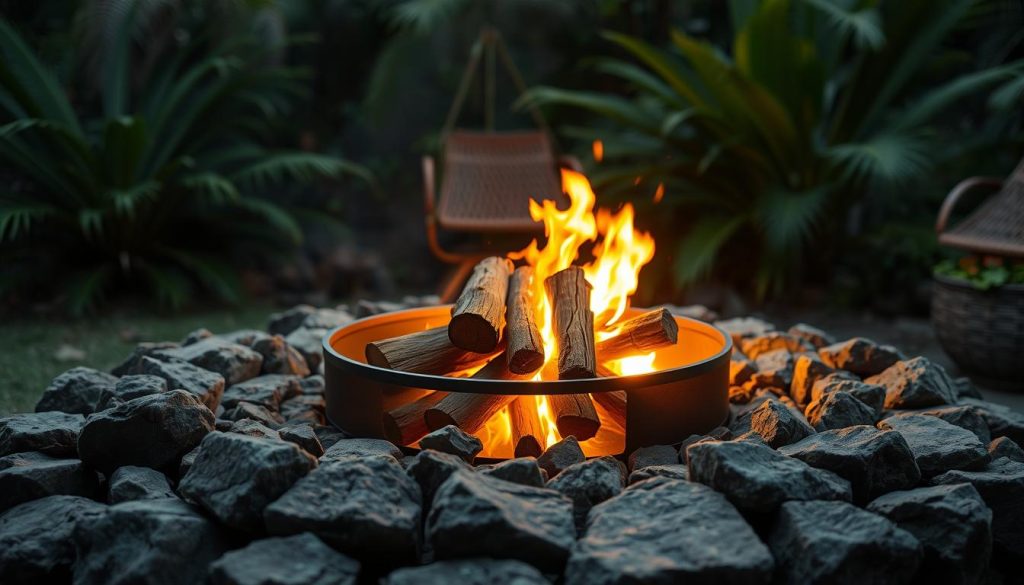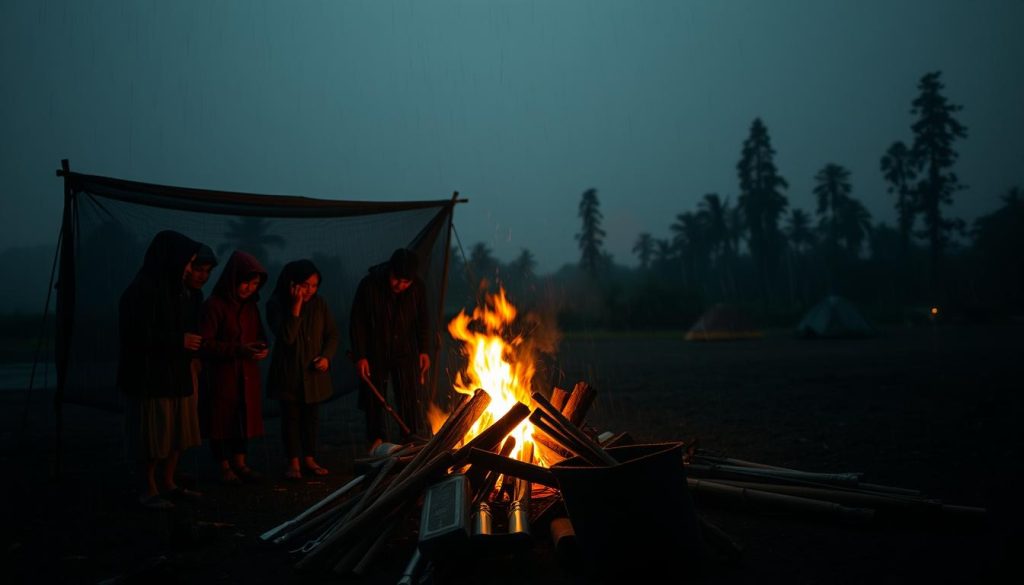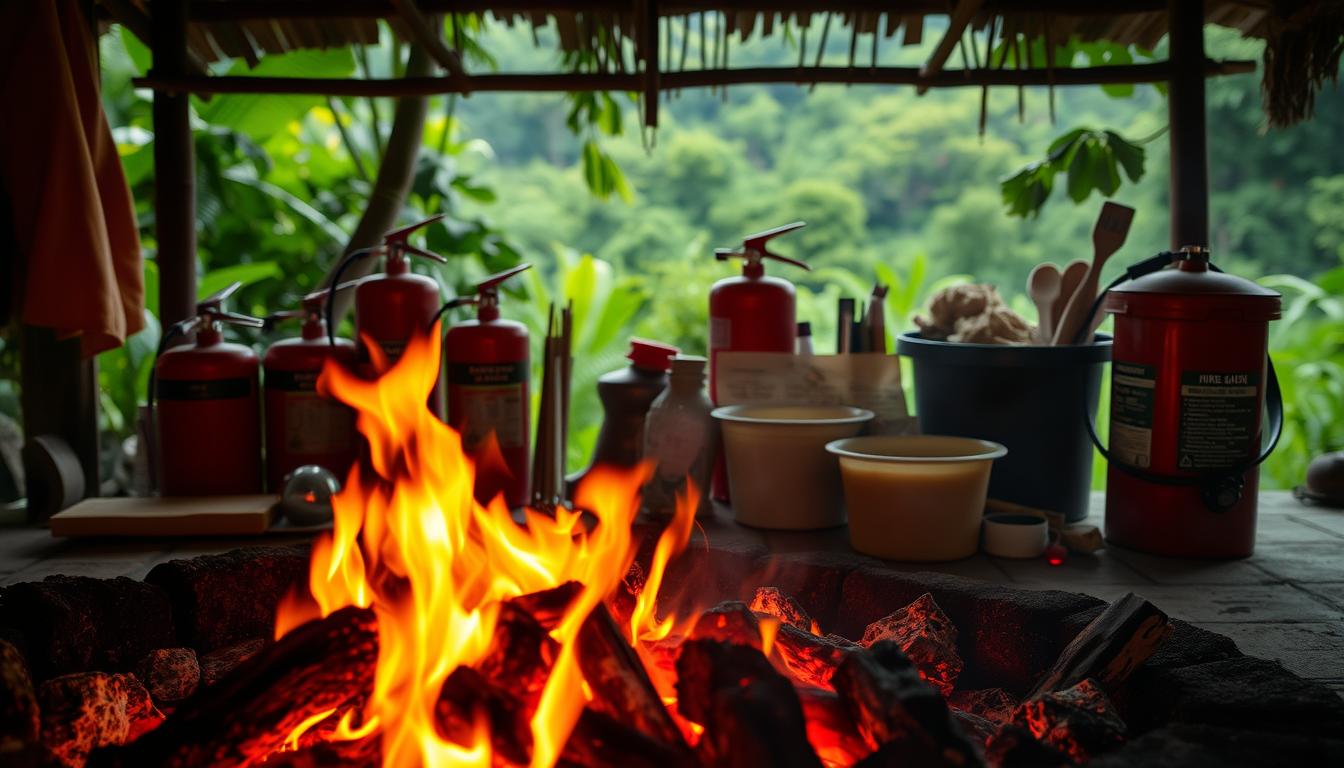Starting a fire in Malaysia can be tough, especially if you’re new here. Whether you’re an experienced camper or just starting, having a campfire can be great.
But how do you start a fire safely and well? In this article, we’ll share key tips on picking the right spot and starting a fire. We’ll also talk about fire safety and walk you through the steps.
Key Takeaways
- Choose a safe location for your campfire.
- Understand local fire safety regulations.
- Use the right materials for starting a fire.
- Monitor the fire and keep it under control.
- Extinguish the fire properly when you’re done.
Understanding Fire Safety in Malaysia
Exploring the outdoors in Malaysia means we must focus on fire safety. It’s key to keep ourselves and nature safe. Knowing the laws and common hazards is essential for a fun and safe trip.
Importance of Fire Safety
Fire safety is critical in preventing wildfires. Wildfires can harm the environment and local communities. By being careful with fire, we protect ourselves and Malaysia’s beauty.
Preventing fires is a big part of fire safety. This means making sure campfires are fully out and being careful with things that can start fires.
Laws and Regulations
Malaysia has laws to keep fires under control, especially in protected areas and during dry seasons. Knowing these rules helps us avoid trouble and keeps everyone safe.
During high fire risk times, some areas might be closed or have fire restrictions. It’s important to stay updated on local conditions to be a responsible outdoor lover.
Common Fire Hazards
Knowing about common fire hazards is crucial for fire prevention. These include dry brush, abandoned cigarettes, and uncontrolled campfires.
We can avoid these hazards by properly throwing away cigarette butts and making sure campfires are fully out before leaving them.
Choosing the Right Location for a Fire
Before starting a fire, we must pick a safe spot. This choice is key to keeping us safe and protecting the environment. It helps prevent wildfires and ensures fire safety.
Several things matter when choosing a spot. We need to think about the land, the weather, and how our fire might spread.
Safety Zones
Finding a safe area for our fire is essential. We look for places without dry leaves, branches, or other things that can burn. A fire ring or a fire pit made of rocks is best. It keeps the fire from getting out of control.
Wind Considerations
Wind is very important for fire safety. A strong wind can quickly turn a small fire into a big wildfire. So, we check the wind before starting a fire. If it’s too windy, we might wait until it’s calmer.
Proximity to Surroundings
How close our fire is to things around it matters a lot. We keep it away from tents, trees, and other things that can catch fire. We also follow any rules from campsite authorities.
To show what’s important, here’s a quick table:
| Consideration | Description | Importance Level |
|---|---|---|
| Safety Zones | Clear area of flammable materials | High |
| Wind Considerations | Assess wind direction and speed | High |
| Proximity to Surroundings | Maintain safe distance from flammable structures | High |
By thinking about these things, we can enjoy our campfire safely. This way, we keep fire safety in mind and avoid wildfires.
Tools We Need to Start a Fire
To start a fire safely and efficiently, we need the right tools. The right equipment makes the process easier and keeps us safe.
Fire Starters
Fire starters are key to starting a fire. We can use lighters or matches for their convenience. For a more traditional approach, flint and steel are reliable choices.
- Lighters: Easy to use and quick.
- Matches: Simple, yet effective.
- Flint and Steel: A primitive yet reliable method.
Fuel Types
The fuel we choose affects how our fire burns. Common fuels include dry wood, charcoal, and kindling. Each has its own benefits depending on the situation.
| Fuel Type | Characteristics | Best Use |
|---|---|---|
| Dry Wood | Burns well, provides sustained heat | Main fire fuel |
| Charcoal | High energy density, burns hotter | Cooking, high heat needs |
| Kindling | Easily ignites, burns quickly | Starting fires |
Ignition Sources
Besides fire starters, the right ignition sources are helpful. Fire starter rods or ferrocerium rods can spark to ignite our fuel.
In conclusion, having the right tools is crucial for starting a fire. Knowing about different fire starters, fuels, and ignition sources makes the process simpler and safer.
Preparing the Fire Site
Before starting a fire in Malaysia, it’s key to prepare the site well. This makes sure our camping trip is safe and fun.
Clearing the Area
First, we clear the campsite area. We remove leaves, twigs, and other things that can burn easily. This includes branches and plants nearby.
To clear well, we should:
- Remove flammable stuff within 3 meters.
- Clear leaves and debris.
- Trim overhanging branches if needed.
Arranging Materials
After clearing, we arrange our fire materials. This includes starters, fuel, and how to light it. Arranging them right helps our fire start well and safely.
Here’s how to arrange them:
| Material | Purpose |
|---|---|
| Fire Starters | To ignite the fire |
| Fuel Types | To keep the fire going |
| Ignition Sources | To start the fire |
Building a Fire Ring
Creating a fire ring is crucial to keep our fire safe. We can use rocks or dig a shallow pit.
To make a fire ring, we should:
- Gather rocks or dig a shallow pit.
- Make a circle with rocks or a ring around the pit.
- Make sure the ring is strong and well-contained.

By doing these steps, we make sure our fire site is ready. This reduces fire hazards and makes our camping in Malaysia safe.
Different Techniques for Starting a Fire
Learning how to start a fire is key for outdoor lovers. Whether you’re camping, hiking, or backpacking, the right method is crucial. It makes a big difference in different weather conditions.
The Teepee Method
The teepee method is a popular way to start a fire. You make a teepee shape with tinder and light it. Once it’s burning well, add kindling, then bigger material as the fire grows.
Advantages: It’s easy to set up and starts quickly.
Disadvantages: It can be hard in windy or wet weather.
The Log Cabin Method
The log cabin method builds a fire with tinder in the middle. Surround it with kindling in a log cabin shape. This method helps the fire breathe and is more stable than the teepee.
Advantages: It gets good airflow and burns longer.
Disadvantages: It’s more complex and needs more material.
The Dakota Fire Hole
The Dakota fire hole digs a hole for the fire and another for airflow. It’s great for wet or windy days as it keeps the fire safe and improves airflow.
Advantages: It’s less visible and works well in bad weather.
Disadvantages: It takes more work because you have to dig.
Each method has its own benefits and works best in different situations. Knowing and practicing these techniques can improve your fire-starting skills. It makes outdoor adventures safer and more fun.
How to Maintain Our Fire Safely
To have a safe and fun camping trip, we must take care of our fire. Keeping our fire safe is key to avoiding accidents and reducing fire damage. We will talk about how to keep the fire in check, manage fuel, and put it out right.
Keeping It Contained
It’s important to keep our fire in a safe place. We can do this by making a fire ring or pit. This stops the fire from spreading. Also, we should clear the area around the fire of anything that can catch fire.
- Clear the area of leaves, twigs, and other combustible materials.
- Use rocks to create a fire ring, or dig a fire pit if allowed by local regulations.
- Monitor the wind direction to prevent sparks from igniting nearby objects.
Managing Fuel Consumption
It’s crucial to control how much fuel we use for our fire. We should only add fuel when needed, and make sure it’s dry and seasoned. This helps keep the fire safe and reduces harm to the environment.
- Use dry, well-seasoned wood to minimize smoke and maximize burn efficiency.
- Monitor the fire’s size and adjust fuel consumption accordingly.
- Avoid overloading the fire with too much fuel at once.
Extinguishing Properly
Putting out our fire safely is the last step in fire safety. We must make sure the fire is completely out before leaving it. This means using water, stirring the ashes, and checking for heat.
“A fire is not truly out until it’s cold to the touch.”
To put out our fire right:
- Douse the fire with water, making sure to saturate all embers.
- Stir the ashes to ensure that all material is extinguished.
- Check the fire for any remaining heat by feeling for warmth with your hand.
By following these steps, we can have a safe and fun camping trip. Remember, fire safety is everyone’s responsibility.
Cooking Over a Fire in Malaysia
In Malaysia, cooking over an open flame is more than just making food. It’s a mix of culture and nature. We make many dishes that are tasty and full of tradition.
Popular Malaysian Dishes to Prepare
Malaysian food is full of flavors, and fire cooking brings out the best. Some favorite dishes include:
- Nasi Lemak: Our national dish, made with coconut milk and pandan leaves.
- Sate: Grilled meat skewers, served with spicy peanut sauce.
- Rendang: A spicy meat stew in coconut milk and spices.
Cooking Techniques
Cooking over a fire needs skill and knowledge of different techniques. Here are some methods we use:
- Grilling: We use direct heat to cook meats and veggies quickly.
- Steaming: A makeshift steamer basket over the fire cooks food.
- Slow Cooking: Dishes like rendang simmer over low heat for hours.
| Dish | Cooking Method | Preparation Time |
|---|---|---|
| Nasi Lemak | Steaming | 30 minutes |
| Sate | Grilling | 20 minutes |
| Rendang | Slow Cooking | 2 hours |
Safety Tips While Cooking
When cooking over a fire, safety is key. Here are some tips we follow:
- Keep a bucket of water or sand nearby to put out the fire if needed.
- Use long-handled utensils to avoid burns.
- Watch the fire’s size and keep it controlled.
“The key to safe cooking over a fire is preparation and attention to detail.” – Outdoor Cooking Expert
By following these tips and techniques, we can have a safe and enjoyable cooking experience over a fire in Malaysia.
Dealing with Rainy Conditions
Exploring the Malaysian wilderness means being ready for rain. Rain can make starting a fire tough. But, with the right methods and preparation, we can still succeed.

Alternatives for Wet Weather
Finding dry material is key when it rains. Look for dry spots under trees or in rock crevices. Dryer lint, small twigs, and dry leaves are great for starting a fire.
Using fire starting tools made for wet weather is also smart. Waterproof matches or lighters are vital for fire prevention in the rain.
Shelter Options
A good shelter keeps us dry and makes starting a fire easier. Natural shelters like caves or overhangs work well. Or, we can make our own using tarps and ropes.
- Look for natural shelters or create one.
- Use tarps or plastic bags to keep dry.
- Keep your fire starting materials dry.
Fireproofing Materials
In fire emergency situations, fireproofing materials are crucial. Fire-resistant blankets or a fire ring made of rocks can save lives. They help manage the fire and prevent forest fires.
Being prepared and knowing the right techniques helps us handle rainy weather. This way, we can fully enjoy our outdoor adventures in Malaysia.
Respecting Nature and Our Environment
To keep Malaysia’s beauty alive, we must camp in an eco-friendly way. This makes our trips better and keeps nature safe for others in the future.
Reducing Our Footprint
Lessening our environmental impact begins with careful actions. Using green camping gear, keeping fires small, and staying away from wild areas helps a lot. These steps protect nature and prevent fire damage.
Understanding Wildlife Impacts
When we camp in Malaysia, we’re visiting the homes of many animals. It’s key to know how we affect them and their homes. Keeping a distance, not feeding wildlife, and keeping food and trash safe are musts. This keeps animals safe and makes our camping better.
Proper Waste Disposal
Getting rid of waste right is key to camping responsibly. We must take all trash, including food and disposable items, with us. This stops pollution, keeps wildlife safe, and keeps our campsites beautiful. Also, make sure to fully put out campfires before leaving them.
By following these steps, we help protect the environment and make camping better. This way, we keep Malaysia’s beauty for everyone to enjoy.
Sharing Our Fire Experience
When we gather around the fire, we bond and make memories. Sharing our fire stories can inspire others to enjoy the outdoors safely.
Building Connections
Storytelling is key to sharing our fire moments. We can swap tales of our adventures and share fire safety tips. This way, we build connections and a sense of community.
Safety First
It’s crucial to focus on fire safety when sharing our experiences. We need to know about fire hazards and how to handle emergencies. The local fire department is a great resource for learning about fire safety.
By sharing our stories and focusing on safety, we can enjoy the outdoors safely. Let’s keep sharing and promoting fire safety.
FAQ
What are the essential tips for starting a fire in Malaysia?
First, pick the right spot for your fire. Make sure the area is clear and safe. Use the right tools to start it.
It’s also key to know about fire safety and local rules.
How can we ensure fire safety while camping in Malaysia?
To stay safe, learn about fire safety. Follow local laws and watch out for fire hazards. Keep your campfire small and controlled.
Also, take steps to stop wildfires and protect the environment.
What are the best techniques for starting a fire in wet weather?
In wet weather, use dry fire starters or fireproofing materials. You can also build a shelter to keep your fire dry.
How can we minimize our impact on the environment while camping?
Reduce your waste and respect wildlife. Keep your campsite clean and avoid damaging nature. Protect Malaysia’s beauty by preventing fire damage.
What are some safety tips for cooking over a fire?
Keep a fire extinguisher close. Manage your fuel and ensure good air flow. Be mindful of your surroundings and keep kids and pets away.
How can we extinguish a fire properly?
Douse the fire with water and stir the ashes. Repeat until it’s out. Make sure to fully put out your fire before leaving it.
What are some common fire hazards to watch out for while camping?
Be careful of dry leaves and twigs. Watch for sparks and embers that can start fires.
How can we maintain our fire safely?
Keep your fire small and controlled. Manage your fuel and watch the wind. Be ready to put out the fire quickly if needed.

